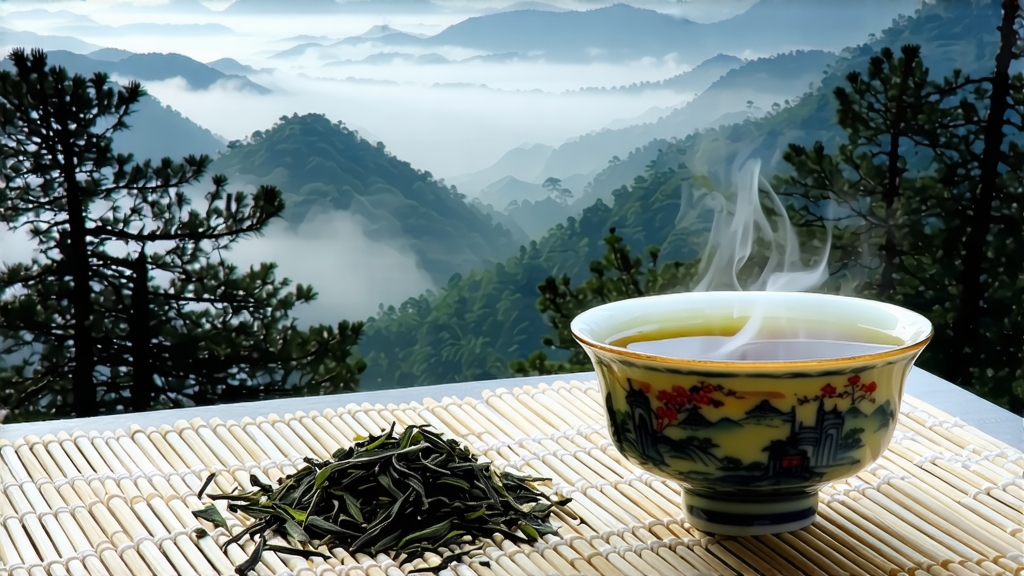
Long before English breakfast blends filled porcelain cups across Europe, a small village in China’s Wuyi Mountains was already perfecting a tea that would rewrite global palates. Lapsang Souchong—today celebrated as the first fully oxidised black tea ever created—emerged sometime around the late Ming dynasty, when desperate farmers accelerated leaf drying over fresh pinewood fires to meet impatient war-time merchants. The accidental marriage of tea and smoke proved unforgettable, and by the early 1600s Dutch traders were loading chests of “bohea” onto East Indiamen bound for Amsterdam, introducing Europe to what it would later call “black tea.” In the process Lapsang Souchong became the prototype for every Indian, Sri Lankan and Kenyan black tea that followed, yet it remains a singular, fiercely regional Chinese treasure.
Geographically the tea is inseparable from Tongmu Guan, a protected gorge inside Fujian’s Wuyi UNESCO heritage site. Here a subtropical monsoon climate, mineral-rich latosol soils and a constant veil of mist slow leaf growth, concentrating amino acids and volatile aromatics. Only six surrounding villages may legally sell authentic Lapsang; outside this micro-zone producers may mimic the style, but connoisseurs dismiss them as “outside mountain” copies. Within the appellation two traditional cultivars dominate: Xiao Ye Zhong (Small Leaf Bush) and the more recent Ai Jiao Xiao Zhong (Dwarf Foot Small Bush), the latter prized for its smaller, more resinous leaves that absorb smoke with elegant restraint.
Processing begins in the cool pre-dawn hours when pluckers gather the standard two leaves and a bud. Speed is critical: the leaves must reach the village workshop within two hours to prevent uncontrolled oxidation. There they are first withered over shallow bamboo baskets suspended above dying embers of local Masson pine; the gentle warmth reduces moisture without “cooking” the leaf. Once limp, the leaves are rolled on split bamboo trays until cell walls rupture and juices stain the fingers a dark copper. Oxidation follows in humid pine-wood chambers where the leaf pile is covered with damp cloths; 90–120 minutes at 26 °C converts catechins into theaflavins, yielding the characteristic reddish leaf and malt-sweet liquor. The critical divergence from modern black-tea protocol arrives with the final drying: workers fire the pinewood roaster until fresh resin exudes, then rake the leaves across iron grates for three to five minutes. A second, slower smoking over smouldering pine embers may last up to eight hours, during which master craftsmen “read” the smoke, adjusting vents so that only the fragrant top-note oils, not bitter creosote, penetrate the leaf. The finished tea is rested in oaken chests for a minimum of 90 days; during this “returning fire” period harsh tar compounds volatilise, leaving behind the celebrated balance of pine sweetness and fruit jam.
International markets usually encounter two stylistic expressions. “Traditional style” or pinewood smoked Lapsang delivers an assertive bouquet reminiscent of campfire, dried longan and winter spice; it is this version that scented the canals of Amsterdam and later the drawing rooms of Victorian London. A newer “unsmoked” or zheng shan xiao zhong, developed in 2005 for the domestic Chinese market, omits the final pine phase, revealing instead honeyed malt, cocoa and the Wuyi “yan yun” or rock rhyme—a lingering mineral coolness said to echo the cliff-side terroir. Both styles share a chocolate-brown, evenly twisted leaf that unfurls to a bright copper-orange cup, yet their aromatics diverge dramatically, offering cuppers a controlled study in the influence of smoke.
To brew either expression gongfu style, begin with a porcelain gaiwan or Yixing clay pot of 120 ml capacity. Use 5 g of leaf—roughly two heaped teaspoons—rinsed for three seconds in water just off the boil (95 °C). Discard the rinse to awaken the leaves and wash away surface tar in the smoked version. Subsequent infusions begin at five seconds, increasing by three to five seconds each steep; a quality Lapsang will yield eight to ten clear infusions. Observe the colour gradient: early steeps shine like polished carnelian, later steeps soften to apricot. Aroma transitions from top-note pine resin (or orchid honey in